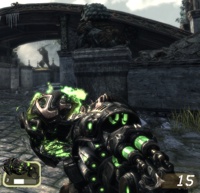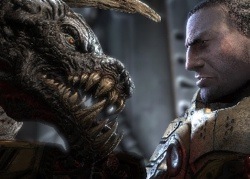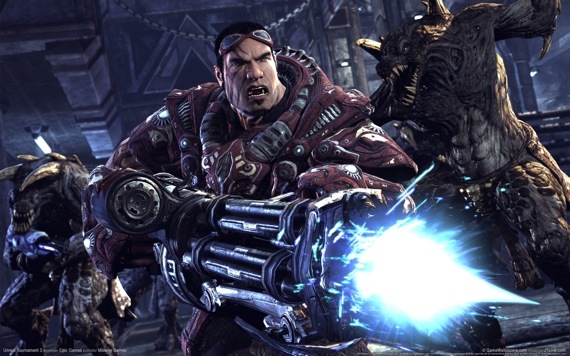Here is the last article of the Jamey Scott Special. It’s an interview with him, talking about the sound of the Unreal Tournament video game series.
Designing Sound: Please tell us how you get involved with Unreal Tournament and how has been your relationship with the audio team and other crews on Epic Games.
Jamey Scott: I was actually pretty heavily addicted to the original Unreal Tournament when I was working for Presto Studios. We used to play on the LAN incessantly. Usually after 6pm into the wee hours of the night. It replaced Quake for many obvious reasons. When Presto closed its doors and I went freelance, I was graced with the lucky opportunity to do some of the UT2003 dialog recordings with Lani Minella who was casting the sessions. Working with Cliff Bleszinski in that capacity gave me the opportunity to do some odds and end for him and eventually he started contracting me more frequently to improve the quality of some of the sounds that were in the game at that point. In terms of my relationship with Epic, I’m a preferred contractor and they hire me when there’s need for sound designs that they think I’ll be able to do well on. For the Unreal Team, I did quite a bit of work for UT2003/UC1. I did a bit of dialog processing for Unreal Championship 2 but not a lot of sound design. For UT2007 (which later became UT3), I think I did the vast majority of the sound design and the dialog processing. I worked on it for a long time and did a lot of very unique designs for it.
DS: In terms of sound, what have been the differences and different challenges between the titles of Unreal Tornament that you’ve been worked in?
JS: The tech has evolved a lot. The first UT game I worked on was UT2003, which was for the original XBox, so space was limited and the Unreal engine was not yet really optimized for next gen sound at the time, so it was still a very old school approach of cramming as much low-res sound as possible into the RAM buffers and hoping for the best. UT3 was a much more liberating game to work on during the design phase, but in the final hour there were some memory issues that forced us to once again cram everything we could into a very small buffer and hope for the best. As a result, the PS3 version of the game didn’t sound as we had hoped for. It was very compressed and hashy sounding and a very large chunk of the content that I had developed for the game had to be cut. That was a bit of a bummer at the time, but there really wasn’t much we could do about it. I have all of my source content in my library from that game and every now and then I’ll happen upon some of it in a search and I’ll be really amused by some of it. I really hope at some point we could do a re-release with a modern audio spec so that some of that great content could be realized as it should have been.
DS: What were the main sources recorded for the sound design of the different elements of the game?
JS: A lot of the designs for UT3 were generated using synthesis. There was a lot of source material recorded but most of it was synthed out so much that the source is pretty obscured. I do remember recording a lot of hardware for the game. Tools and mechanical devices mostly. Lots of metal clanging and impacting. For everything related to the Necris had some sort of sinister vocal element to it so I recorded a lot of vocals and ran them through vocoders and that sort of thing. But the real core of the game’s sound design is synth and fx.
DS: In the Gears of War interview you told me that you consider a lot of the sounds of UT3 as some of your best works. Could you tell us about some examples of those favorites, how you created?
JS: There is a lot of high-end color in UT3 sound that didn’t exist in the Gears of War universe. Sounds like the weapon pickup sounds, health regen sounds, gravity boots, teleportation fx, and so on… these sounds all have a lot of cool synth colors to them that are a lot easier to define as “signature sounds”. You hear those sounds and it’s unmistakeable where they came from… for me at least, and probably anybody who spent a lot of time playing UT3. I know this is sort of a rushed interview so I can’t really do much of a detailed explanation of how I made them, but in general, I spent a lot of time tweaking synths and then printing interesting results, and then I would layer different things together, be it real sounds or synthesized sounds, and then I would add effects or have an effect concept and then I would just create these huge batches of sounds just tweaking and layering. Then I would narrow them down into categories and then eventually settle on the best of the best. I would submit hundreds of sounds for a single event and then we’d narrow down the choices by ultimately what sounded the coolest.
DS: You also talked about your goal of “make everything feel weighty” and explained several things about doing big sounds. Does this also present in UT games? How was the general approach to the sound of these games?
JS: Well, weight wasn’t really as important of a consideration in the UT universe as it was in the Gears universe. In UT I generally designed sounds that have a very thorough frequency range.. the highest of the highs, the lowest of the lows, and everything in between. Most sounds needed to be signature events so most of the designs I did were totally over the top and could cut through blasting music and huge battles of 8 or more players. Frequently, it became a cacophony of sound, but the playback hierarchy was always logically laid out so that the most important game cues would always have priority, especially in large battles.
DS: How is the approach on the weapons and different special powers of the characters of UT?
JS: The weapons in UT are all these crazy ballistic sounds with over the top hardware mechanisms and extreme layered booms. There was rarely any restraint used in making the sounds. As crazy as I wanted to go, the more enthusiastic Epic would respond, so that’s sort of how it went.
DS: Could you tell us how you created some of the main big creatures of the game?
JS: In UT3, most of the creatures were the Necris faction which were mostly deep, synthy vocals and tentacle whips, if I recall correctly. I don’t think I created any specific creature sounds like I did for Gears other than the voice processing which all had voice actors playing specific roles. I did create all of the dialog processes for most of the UT games, which included all of the creatures, humans, and robots.
DS: You worked on the cinematics as well. How was your approach there in terms of sound design and mixing?
JS: I did the cinematics for UT2003 which was 8 years ago. I’d be hard-pressed to remember much about that experience at all. I remember that I mixed them in Digital Performer v.2.5 which was on MacOS9 so the sessions are totally obsolete and unopenable at this point. I didn’t do the cinematics for UT3, that was Soundelux, I believe. I did create a lot of the content for them, so I’m credited as sound designer but I was not involved with the scene specific content and mixes.
DS: How involved were you with the implementation process? How was it achieved? Was there something in the implementation system that affected the way you design sounds for the game?
JS: I started out implementing sounds into the packages for the vehicles early on but I didn’t really know the unreal engine all that well back then so I was doing very basic implementation. At the time, there wasn’t a lot of audio tech in the engine so we were really just doing basic wav file playback. Epic eventually took over implementation responsibilities and I became more of a content provider.



